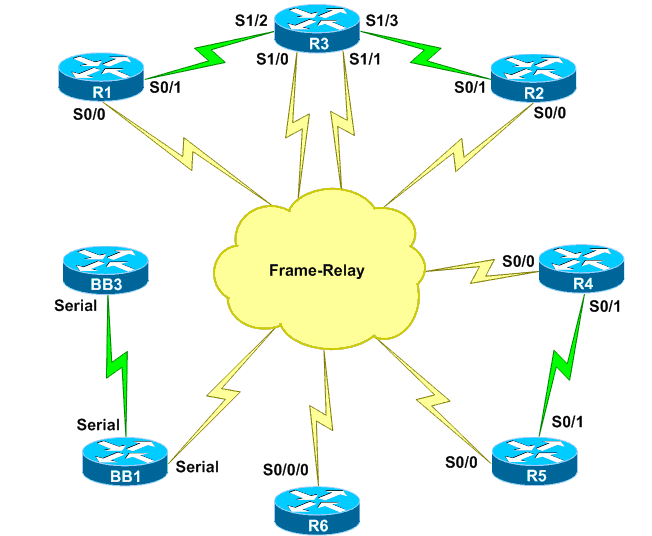When you learn CCIE R&S Certification (or any other track), you will have to spend a lot of time (between 600 and 1000 hours) configuring routers and switches. I have a lot of questions about CCIE lab equipment, such as:
What routers or switches should I buy?
How many routers or switches do I need?
Can I use SPOTO for labs?
In order to answer all these questions, I decided to write this tutorial. I will answer all these questions and more. This tutorial is the 100 percent latest version of the latest version of CCIE R& S Labs (V5)
Topology
When you study for CCIE you really should use the workbooks from one of the vendors like SPOTO. You can use the CCIE R&S blueprint and study some of the topics on your own but these guys already did all the work for you by creating labs. Personally I used the workbooks from INE when I was studying for CCIE R&S.
Each of these suppliers uses a lab topology for all their laboratories. Most topologies have four switches and nine routers. Three of these routers are backbone routers, almost the same as you expected in the CCIE R&S lab exam. The backbone router is pre-configured and out of control. They are used to inject routing information and other clever techniques.
The number of routers and switches and interfaces, cables, router and switching models and IOS versions will depend on the topology you will use.
To give you an idea what a lab topology looks like, here’s what SPOTO uses:


Routers use serial interfaces to connect to each other, and there are many FastEthernet links. Before you start thinking about laboratory equipment, you should first determine which vendor workbook to use. Each vendor has a list of routers, switches, interfaces, and IOS versions they use.
Physical topologies never change throughout the workbook, and you can use such a lab to make unlimited logical topologies.
Having said that, let’s look at your choices when it comes to equipment.
Real Equipment
When I talk about real equipment, I mean physical hardware, what you’re buying on eBay. That sounds good, isn’t it? With its own lab, access it anytime, anywhere.
That sounds good, but I don’t recommend it. I set up my own laboratory, but only because I wanted to keep it after I passed it. I still use it when I create tutorials for this site. Here are some shortcomings:
Setting up your own lab is expensive, even if you can sell most of your hardware after you finish school. 12 months from now, it’s hard to say how much money your old hardware will get, and you may not get much in return. When you are on a budget you might be tempted to replace some routers or switches with cheaper models.
The problem is that cheaper switches do not support certain features. For example, you can get a 3550 switch instead of a 3560 switch, but it does not support all IPv6 features or dedicated VLAN. It takes time to find out what the lab can’t do.
You need a terminal server to access the remote console. The Cisco 2511 is an excellent terminal server, but it’s not cheap. Nine routers and four switches consume a lot of electricity, generate heat and produce a lot of noise.
This is not the living room you want. It takes a long time to buy all routers, switches, and interfaces. You also need to make sure that the router has enough RAM and Flash to store the IOS image. Depending on where you live, it may be difficult to obtain equipment.
eBay is great, but the freight may be high. Before purchasing any hardware, carefully check that it can be used in version 5 of CCIE R / S Labs. In the previous version (v4), the real lab had 4 x 3560 switches, which is what all vendors are using.
Starting with version 5 of the lab exam, Cisco does not use a specific switch model and the entire lab is virtual. Cisco released a document where they explain which router and switch support all commands:
Cisco ISR 2900 with IOS 15.3T Universal software release
Cisco 3560X with IOS 15.0SE Universal (IP Services) software release
If you have to use these devices to build the entire lab, it will be expensive. 2811 and 1841 routers can also run IOS15.x, so you can use them.
I checked the 3560x configuration guide, and it is possible that the old 3560 running the latest version of IOS 12.x should cover 99 percent of the topics.
If money is not a problem and you like to have your own lab, go. If your goal is just to be CCIE, then I don’t recommend doing so. It’s too time-consuming.
GNS3
GNS3 is a great simulator that is very useful when you study CCIE R & S. This is useful when you want to create your own lab/ topology when you’re learning something. I do not recommend using it to build one of the vendor topologies, but the reason is as follows:
GNS3 does not support switches, only routers. The closest to switching is to use the switch module in the router, but it supports only a small number of commands required by the CCIE RS lab. You can solve this problem by connecting a real switch to a GNS3 router. This is done through the Breakthrough switch or multiple network cards.
Support for IOS 15.x is limited. I believe that only 7200 routers can run IOS 15 in GNS3, and some other routers like 3725 can’t. You need some memory. Each router uses about 256 MB, so you use nine routers, so you need more RAM than 2GB to run a large topology.
There are some errors in GNS3 (after all, it’s a simulator). In the past, there were some problems with Multicast and NTP. When something doesn’t work just to find out that your configuration is correct but GNS3 is acting weird, it’s really bad.My advice.
GNS3 is ideal for building fast topologies and practicing your own lab. Don’t use it to build a complete lab topology. Small things like multicasting don’t work properly, and connecting real switches to virtual routers can also cause problems. They need time to solve more problems in actual learning
IOU (IOS on Unix)
Cisco no longer uses real hardware for R&S lab or partial rack rental. The IOU (the IOS on Unix) is used by them now. Basically it is a simulator running on Unix/ Solaris, such as GNS3, but it does not use that many resources. There is also an IOL running on I86 and Linux (IOS on Linux). A front-end called the "web-IOU" was created for it.
IOU supports routers, as well as layer 2 images that support switching commands. Not everything is supported, but switching it is better than GNS3.
At present, Cisco has not officially released IOU, to the public. It also has some loopholes. This may be the future of CCIE Family Laboratory.
Cisco VIRL
Cisco’s emulator is called VIRL, to support router and switch simulation (since April 2015). I haven’t tried yet, but I think VIRL will be a good substitute for GNS3. Out of the box routing and switching support, it runs IOS 15.x. This may be an option, but you have to see for yourself.
Rack Rentals
Rack rental is very simple. You need to pay for and access the remote lab via telnet, which provides you with cable and configuration.
You don’t have to worry about anything. Hardware, interfaces, cabling, IOS images, GNS3, and so on. All this is done for you. As the previously mentioned suppliers are very popular, there are many companies providing rack rental services for their topology. There are some important advantages:
Everything is ready. If you pay for it and get access, you can experiment immediately. You can spend your time doing laboratories instead of building them.
The lab in the workbook has a startup configuration for each device to copy/ paste the devices to 13 devices for the time. Most rack leases have scripts that automatically copy the correct boot configuration to all devices.
Conclusion
I suggest rack rental because it is the most effective way. Since you want to be CCIE, the first thing you need to focus on helping you achieve your goals is the lab. Don’t waste your time building a lab or messing up the simulator. With rack rental, you can learn immediately.
I hope this will help you. Feel free to share with your friends. If you have any questions or need to share, please comment in our forum.
Note: SPOTO has developed some theoretical training courses, and we have 16-year IT training experience in Cisco certification. if you want to further study, and you can contact us!
More you may be interested:
1. Top 10 IT Certification for Networking Engineers 2019
2. CCNA vs CCNP – Scope, Salary and Job Opportunities
3. Will 5G Networks Require New Network Engineer Skills?
4. Top 10 Network Troubleshooting Commands Every IT Pro Should Know

 Join Telegram Study Group ▷
Join Telegram Study Group ▷














